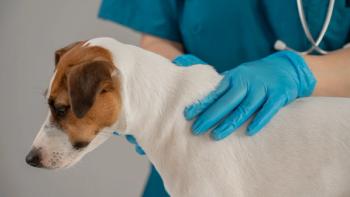
Just Ask the Expert: How do you manage ceruminous otitis in cats?
Veterinary dermatologist Dr. Paul Bloom discusses how he handles these cases.
Dr. Bloom welcomes dermatology questions from veterinarians and veterinary technicians.
I frequently see cats presented for wellness evaluations that have unilateral or bilateral ceruminous otitis externa. These cats’ aural pruritus ranges from none to severe; most cats have minimal or no pruritus. Cytologic examination often reveals Malassezia species. I often treat these cats with Otomax (Intervet/Schering-Plough Animal Health). Please comment on this problem—the cause, the therapy, and your views.
A. Asymptomatic otitis externa in veterinary patients is asymptomatic from the owner's observation, and it is not uncommon in dogs or cats. In many cases, the animal has had previous episodes of otitis externa, and its pruritus threshold has been raised. Please note: This increasing threshold reinforces the recommendation that when you treat animals that have otitis externa and clinical signs, a follow-up examination during therapy is essential to confirm disease resolution vs. resolution of only the signs.
Paul Bloom
Regarding the cause and treatment of ceruminous otitis externa in cats, remember that otitis externa, regardless of the type of discharge, is a sign of an underlying disease. So you need to consider both primary and perpetuating factors.
Primary factors—such as Otodectes species, cutaneous adverse food reactions, environmentally triggered atopic dermatitis, and aural polyps—cause otitis externa. Perpetuating factors do not initiate the problem but will cause the disease to continue unless they are also treated. Perpetuating factors include
- Bacteria (cocci, most commonly Staphylococcus pseudintermedius [acute infections]; beta-hemolytic streptococci and rods, most commonly Escherichia coli, Pseudomonas species [chronic infections], and Proteus, Klebsiella, and Corynebacterium species)
- Fungi (Malassezia pachydermatis, which may cause a hypersensitivity reaction; therefore, small numbers may be relevant)
- Progressive pathologic changes (e.g. fibrosis or hyperplastic ceruminous glands from chronic inflammation)
- Otitis media
- Contact hypersensitivity or irritant (identified when an owner reports at a recheck examination that the pet was doing well the first three to five days of treatment but now resents having its ear treated; typically on this examination an erythematous papular eruption is present on the pinna)
- Treatment errors (most commonly undertreatment)
With Otomax, you are effectively addressing many possible perpetuating factors. But remember that in recurrent cases, you also need to address the primary factor. Since most causes of otitis externa may also cause skin disease (and vice versa), I always inquire about previous skin disease in addition to documenting any previous episodes of otitis externa. If a cat has never had an episode of otitis externa or any skin disease in the past, treating the perpetuating factor may result in a cure or at least long-term remission (years). In those cases, I suspect the cat has subclinical or mild allergic disease (cutaneous adverse food reactions or environmentally triggered atopic dermatitis), and only under the right circumstance will the pruritus exceed threshold and cause clinical signs. This may be similar to cats that vomit every three or four months. They probably have mild low-grade inflammatory bowel disease that causes only infrequent clinical signs.
So when I diagnose otitis externa in a cat that has never had skin or ear disease in the past, I eliminate Otodectes species as the cause and always treat the perpetuating factor. I also discuss with the owner the possibility of needing to perform other diagnostic tests if the otitis recurs or does not resolve. In those cases, I investigate the primary factor in addition to treating the perpetuating factor.
Paul Bloom, DVM, DACVD, DABVP
Allergy, Skin and Ear Clinic for Pets
31205 Five Mile
Livonia, MI 48154
SUGGESTED READING
1. Scott DW, Miller WH, Griffin CE. Diseases of eyelids, claws, anal sacs, and ears. In: Muller & Kirk's small animal dermatology. 6th ed. Philadelphia, Pa: W.B. Saunders, 2001:1185-1235.
2. Morris DO. Medical therapy of otitis externa and otitis media. Vet Clin North Am Small Anim Pract 2004;34:541-555.
3. Griffin CE. Otitis externa and media. In: Griffin CE, Kwochka KW, MacDonald JM, eds. Current vete rinary dermatology. St. Louis, Mo:Mosby-Year Book, 1993;244-262.
4. Rosser EJ Jr. Causes of otitis externa. Vet Clin North Am Small Anim Pract 2004;34:459-468.
Newsletter
From exam room tips to practice management insights, get trusted veterinary news delivered straight to your inbox—subscribe to dvm360.




